Quick note: this originally ran as two separate-but-related articles at the late, lamented Comics MNT. Alas, nothing is permanent on the internet; but I like these pieces too much to let them succumb to link rot. So here they are, together at last!
1. The Complicated, Slightly Better Manhood of Achewood
Remember Chris Onstad’s Achewood? If you care enough about comics to be reading the MNT and were online between 2000 and 2010, you must. For most of the first decade of this century, Achewood was one of the flagship webcomics when webcomics were an exciting new cultural space; it might not have had the reader numbers of some of the topical gamer strips, but its cultural presence was huge and it was very much the critical darling of the scene.
If you need a refresher: Achewood was a weirdly erudite, often filthy, funny-animal strip with minimalist Charles-Schulz-with-Adobe-Illustrator black and white art and aggressively unconventional lettering (almost certainly the only landmark comic to be lettered in the Chicago font). The cast was distinctive; the strip centered on Ray Smuckles, an oblivious but goodhearted thong-wearing rap mogul cat, and his depressed computer-programmer friend Roast Beef Kazenzakis. Other major characters included an avuncular novelist bear, another bear who loves food and The Cure, an eternally childish, bottomlessly naive otter, a couple of eastern European robots, and several others. And yes, all of these listed characters are male, and yes, that will become important later.
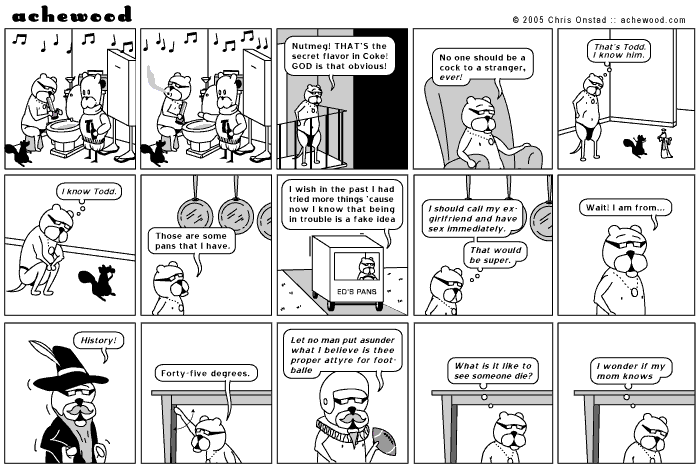
All art exists in a specific cultural context. In Achewood’s case, that context was the webcomics boom of the 2000s, a time not that long ago chronologically but already receding into the distant past culturally. The ability to make comics and get them in front of people without going through syndicates or publishers was new and intoxicating; cultural standards for what was and wasn’t OK were extremely different. I can’t prove this with science and graphs, but my impression is that webcomics of this Cambrian explosion period tended to be weirder and more idiosyncratic than they are now, with over a decade’s worth of conventions having been developed.
Achewood was certainly weird and idiosyncratic. It still is, in a manner of speaking; Onstad has stopped producing new strips, but the entire archive is still available online, and at least in my comics-aware, middle-aged online social circles the strip lives on as a set of shared cultural shorthand. A panel of Roast Beef, the strip’s avatar of crushing depression, waking up and thinking to himself “Oh no it’s today” gets tossed around with nearly weekly frequency.
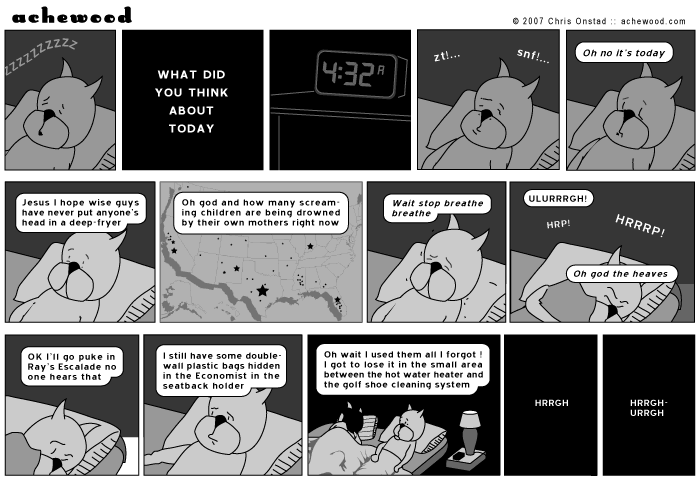
If the strip is a (treasured) relic now, though, it’s important to remember that in its day it was the exciting, vital, beating heart of the webcomics boom. If you were aware of webcomics, you at least had an opinion about it. 2006’s Great Outdoor Fight storyline marked the height of Achewood’s cultural presence, gaining a high-enough profile to receive a (still-available) print collection from Dark Horse, which was subsequently named Time Magazine’s #1 Graphic Novel of 2007.
It’s fitting that The Great Outdoor Fight was Achewood’s standout moment, because the sequence is an encapsulation of the strip’s just-below-the-surface central concern: an examination of manhood, the criteria by which it is evaluated, and anxiety over not meeting them.
To unpack this, we should probably do a quick walk through the storyline itself. It’s a long and complicated one, beginning with a startup that provides silicone testicles to be attached to cell phones (the concern with masculinity isn’t always subtle) and morphs quickly into Ray Smuckles trying to live up to the legend of his father, who once won an annual competition wherein 3000 men spend three days brawling in an open-air enclosure.
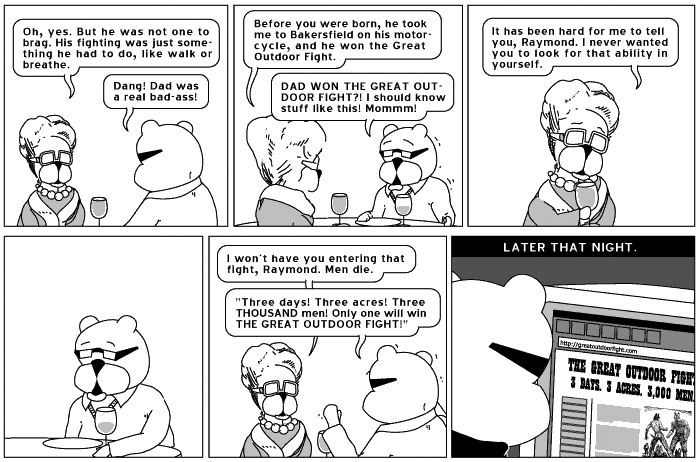
It’s all much more convoluted than this, of course, and much funnier. But the concerns with manhood—both directly and indirectly through other concerns closely associated with manhood, like fatherly approval—are everywhere. They range from the immediately anatomical (truck nutz for cell phones, a panel where a character is so fired up he wants to play a trumpet with his member) to the conceptual: am I man enough for my badass father? Do I have what it takes to beat the hell out of 3000 other men? Why does society reject me, and what do I do with all of the anger this produces? Do I care enough about my kids to lose face by pretending to lose a fight to someone widely considered a wuss so that he’ll stop calling the cops about my Christmas decorations (this is a real plot point)? What do I do when authority tells me I can’t do something? Does an effective leader of an army of angry men share his rotisserie turkey and cheap brandy, or keep it all to himself?
At a glance, the outlook both presented and satirized in the Great Outdoor Fight falls solidly under the rubric of “toxic masculinity:” manhood and fatherly approval come from being the best at beating people into jelly, and women only exist as vectors for shame and beatdowns (the first thing Ray does in the fight is to exploit an opponent’s rage over his wife’s spending habits).
But it’s more complicated than that. Yes, the entire storyline is a test of manhood for Ray Smuckles that he passes by beating a bunch of people up. But his final, ultimate passage comes from rejecting a set of rules (and it doesn’t take much in the way of English majoring to see the Great Outdoor Fight’s institutional rules as stand-ins for the traditional codes of toxic masculinity) in favor of his own. Moreover, Roast Beef is as much a winner of the Great Outdoor Fight as Ray is, and he does this using his brain the entire time, without ever punching anybody. Roast Beef is actively modeling a different, more cerebral, mode of manhood.
This pattern shows up even more explicitly in the later Badass Games storyline.
In these strips, Ray and Beef (serving as the comic’s authorities on manhood) hold a set of games wherein the rest of the male cast compete to see who’s more of a badass man. But the nature of the competition winds up being a surprise: they bake bread, they pick a car, they try to convince an inmate that they’ve done hard time, and they stare down a mean dog. Even more surprising though: in each case, the avuncular, cultured senior citizen Cornelius Bear winds up winning. Badass manhood, the strip says, depends much more on culture and experience than it does on the ability to beat a dude raw.
Only space and fear of mental fatigue stop me from detailing the many other times Achewood swerved into concern with manhood and its trappings. There was the time Ray wouldn’t help a friend until he took back some mean things he’d said about Ray’s junk. The storyline where Beef accidentally kills a man by giving him an improper compliment in a gym locker room. The arc where Ray, Beef, and Teodor discover that cantilevering heavy objects off of the front of their underwear gives them an unearthly sense of well-being (tellingly, in this state they talk to moving off into a place largely without women).
Hell, there are several entire essays to be written about the strip’s revelation that depression-avatar Roast Beef was born with ambiguous gender and originally named Cassandra, examining this retcon from both the feminist and intersex/trans identity angles. (quick note here: I’m not for a second saying that intersex people in the real world are walking Metaphors for Gender Issues. But when a cartoonist with some clearly heavy gender baggage abruptly retcons a main character to be intersex, that’s certainly textually interesting)
Like many things from the past, even the recent past, Achewood has cultural rough edges that it was able to skate on in 2006 but which raise eyebrows now. Reading back through the archives means encountering the casual use of gay slurs, for instance, as well as a steady diet of gay panic jokes. But more relevant is the strip’s gender politics. A look into the possible misogyny of Achewood would be adjacent to this article but not exactly the program here (watch for that some time soon); but we have to acknowledge that, if the strip is a fascinating but flawed masterpiece, it’s also, for virtually all of its run, a total sausage party. Only one female character, Molly Sanders, could be argued as central to the strip, and even she exists mostly as a foil for Roast Beef’s depression-makes-me-a-bad-partner antics. Achewood (hilariously) displays a world by, for, and of dudes pursuing dude concerns, with a surprising number of plot- and punchlines directly evoking genitalia.
And here’s an interesting thing: throw out the “hilarious” part, and that last sentence also describes the surprisingly complicated gender politics of the novels of Ernest Hemingway. The parallels are many. Onstad and Hemingway both stand out for their skilled, off-the-beaten-path use of the English language. Like Onstad’s, Hemingway’s work on the surface is all about men doing manly things and trying to compete (with a manly fashion) with each other over who exudes more raw testosterone (also like Onstad, Hemingway often implicates genitalia, if slightly less explicitly; the hero of The Sun Also Rises spends the entire book fretting over a catastrophic wound between his legs); both literary worlds contain a whole lot of drinking. But Hemingway’s manly men are all emotionally wounded and insecure, and if you poke at the text just a little bit, it’s clear that the source of their pain is the struggle of living up to impossible codes of manhood.
Probably unintentionally, Hemingway’s books serve as vivid indictments of what we now frame as toxic masculinity (I think Hemingway knew that something was bad about what society expected from men, but was too trapped in his own time and culture to be able to formulate it in an explicit way, instead just sort of accidentally smearing a composite portrait through his entire body of work). The same thing is going on in Achewood, except with a touch more intentionality and with a little bit of progress on the problem of coming up with suggestions for alternate ways to be.
Ray Smuckles and Cornelius Bear could easily sit down and go drink for drink with any of Hemingway’s wounded heroes. The big difference is that if a lion charged them on safari and they flinched, Ray wouldn’t have the life-destroying crisis of confidence that Francis Macomber did; he’d just smoke a joint and make up silly raps with his friends in his Escalade. That’s not anywhere near a perfect model of manhood, there’s all kind of growth needed there. But it’s at least a big improvement.
2. Ray Smuckles: Nobody’s Role Model
Recently, I wrote a longish thing for this site arguing that Chris Onstad’s seminal webcomic Achewood was, in between all the ridiculous rapping and searches for the Saddest Thing, ultimately concerned with manhood. In the process of writing that piece, a question kept nagging at me, one that was right next to thing I was investigating, but just separate enough that I felt like I couldn’t really address it in a story that was already bursting at the seams. But it was an important question, one that I didn’t want to short-change: did Achewood have a misogyny problem?
Think about the cast: only Molly gets the barest hint of an interior life, and even then most of her existence, thoughts, and emotions revolve around Roast Beef.
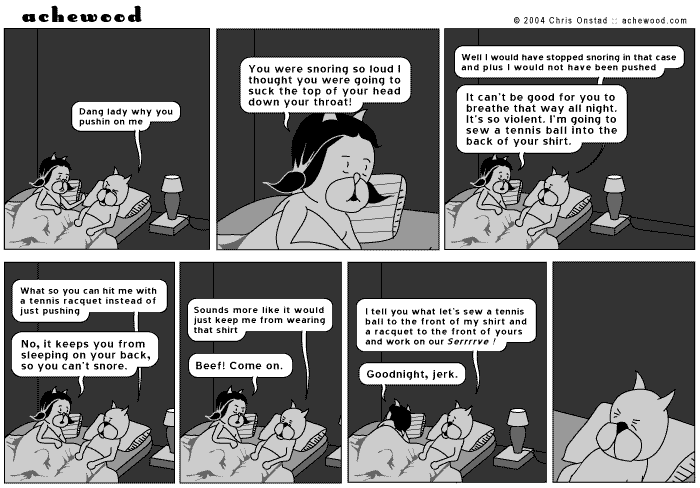
She, like most of the strip’s minimal roster of women, initially appeared only as a reward for Beef. The same essentially goes for Polly and Penny (respectively, rewards for Cornelius and Teodor), except that they get much less on-panel time. Consider Polly’s introduction: the male cast goes to a strip club, and a previously-depressed Cornelius—who the strip had previously established was the most badass of all the male characters—wins over a stripper with his worldliness. They take off and spend a few days together. Polly gets a hint of an inner life in that we do see her having some thoughts and feelings, but she exercises almost no agency, and then vanishes from the strip, having been there to emphasize the strength of Cornelius’ manliness game.
(Polly’s storyline is particularly frustrating because, viewed in isolation, it actually makes an interesting, enlightened point that the male cast go into the strip club viewing the workers as interchangeable machine parts, but the elevated Cornelius sees them as people worth knowing; but any awareness present here gets undermined by the wider context, and by the way Polly ghosts away)
When women aren’t prizes in Achewood, they’re impediments: think of the roles Ray’s and Phillipe’s moms play, or the way Molly is used half the time, or, as mentioned in the last article, of the way Ray uses a guy’s wife as a vector to beat him down during the Great Outdoor Fight. This isn’t misogyny in the direct sense of an open statement that women are inferior; but it reflects a systemic misogynist priority. Women don’t matter enough to be fully-realized parts of the story. Todd the dirtbag squirrel has more of an inner life than most of the women.
I don’t think that Chris Onstad hates women, or that the strip ever overtly positions itself as hating women (as a class, at least; it sure seems to hate Ray’s ex-girlfriend Tina).
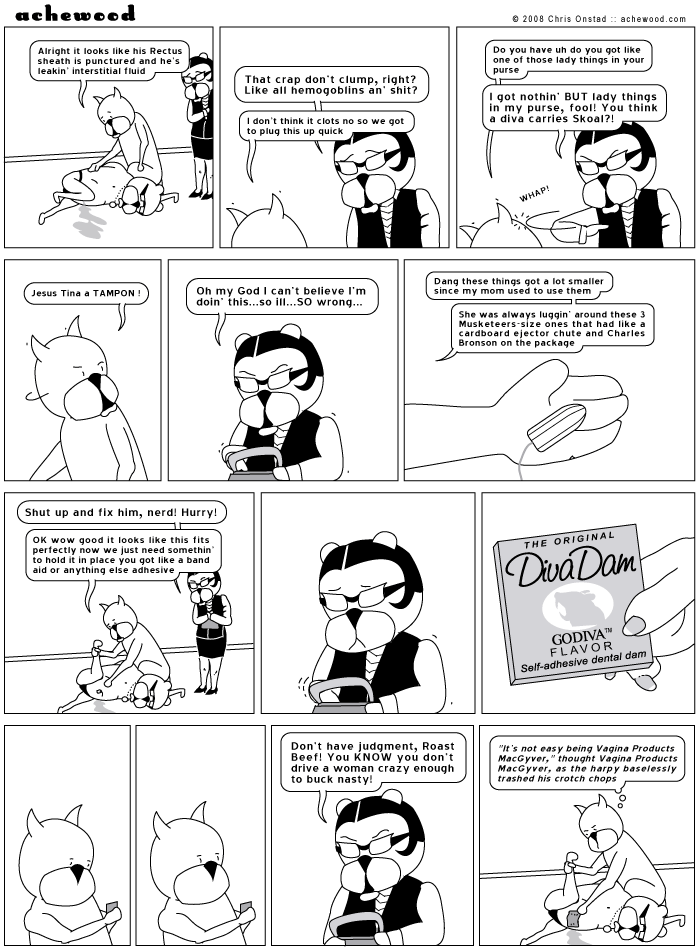
But in that last article, I described Achewood as a strip “by, for, and of dudes pursuing dude concerns” and I think the strip’s extreme focus on the world of men, largely to the exclusion of anything else, is something we have to acknowledge and look at. Ray, Beef, and Teodor at one point become extra-manly by dangling heavy objects off of the front of their underwear and then fantasize about going off to a place without women (except for brief visits for sex), for god’s sake.
I do want to park the prosecution here for a second to acknowledge the cultural context in which this was all written. The 2000s webcomic boom produced some shockingly toxic, misogynist stuff. If Achewood is guilty of a form of misogyny by omission, it still comes off pretty well in comparison to garbage like Shredded Moose or Dominic Deegan or still-running edgelordiness of Penny Arcade. Onstad wasn’t great to women, but he didn’t appear to publicly hate them, either. He just doesn’t take them seriously as people within the context of the strip.
I’m a diehard fan of the movies of Joel and Ethan Coen; I think the Coens are some of the smartest, best artists to have worked in America in the past 30 years, and their films always have interesting things to say about society, often while being hilarious. Their movies are also overwhelmingly white and straight. This doesn’t disqualify them as great filmmakers, but it does stand out as a thing you have to acknowledge when praising their greatness. They have a blind spot. That might or might not be enough to make you stop watching, and it’s not like there’s a morally clear right answer there. Tolerance for flawed, blinkered worldviews in artists is a matter of lines drawn by each person within the bounds of their own conscience. But it’s a thing you have to account for, both if you’re telling someone about their greatness and if you’re trying to extract meaning about the wider world from their films.
And so it goes for Onstad. I’m comfortable calling Achewood a work of genius. It’s brilliantly executed, it brings me joy, and it helps me make sense of the world. But it’s a work of genius that sits within some frankly a little disappointing cultural boundaries. I could write an extended series of these articles looking at the strip’s flawed or fraught approaches to LGBTQ issues or to American race relations or cultural appropriation. These flaws exist. But they’re not enough to make me walk away from it, although I respect the opinions of people for whom they are. For me, it’s enough just to remember that while Ray Smuckles has a lot of good qualities, he’s nobody’s role model.